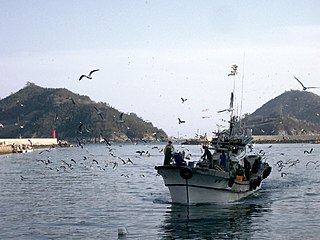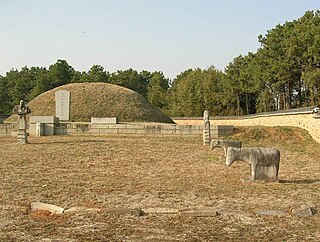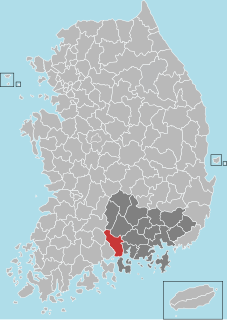Related Research Articles
Korea's provinces have been the primary administrative division of Korea since the mid Goryeo dynasty in the early 11th century,and were preceded by provincial-level divisions dating back to Unified Silla,in the late 7th century.
South Gyeongsang Province is a province in the southeast of South Korea. The provincial capital is at Changwon. It is adjacent to the major metropolitan center and port of Busan. There is UNESCO World Heritage Site Haeinsa,a Buddhist temple that houses the Tripitaka Koreana and attracts many tourists. Automobile and petrochemical factories are largely concentrated along the southern part of the province,extending from Ulsan through Busan,Changwon,and Jinju.
North Jeolla Province,also known as Jeonbuk,is a province of South Korea. North Jeolla has a population of 1,869,711 (2015) and has a geographic area of 8,067 km2 located in the Honam region in the southwest of the Korean Peninsula. North Jeolla borders the provinces of South Jeolla to the south,North Gyeongsang and South Gyeongsang to the east,North Chungcheong to the northeast,and South Chungcheong to the north.

Jeolla Province was one of the historical Eight Provinces of Korea during the Kingdom of Joseon in today Southwestern Korea. It consisted of the modern South Korean provinces of North Jeolla,South Jeolla and Gwangju Metropolitan City as well as the Jeju Province. The provincial capital was Jeonju,the current capital of North Jeolla. The entire inland region was called Honam,which is still commonly used today.

Jeonju is the 16th largest city in South Korea and the capital of North Jeolla Province. It is both urban and rural due to the closeness of Wanju County which almost entirely surrounds Jeonju. The name Jeonju literally means "Perfect Region". It is an important tourist center famous for Korean food,historic buildings,sports activities,and innovative festivals.

Kaesong is a special city in the southern part of North Korea,and the capital of Korea during the Taebong kingdom and subsequent Goryeo dynasty. The city is near the Kaesong Industrial Region close to the border with South Korea and contains the remains of the Manwoldae palace. Called Songdo while it was the ancient capital of Goryeo,the city prospered as a trade centre that produced Korean ginseng. Kaesong now functions as the DPRK's light industry centre.

Haenam (Haenam-gun) is a county in South Jeolla Province,South Korea. The capital of Haenam-gun is Haenam-eup.

Gimje (Gimje-si) is a city in North Jeolla Province,South Korea.

Sangju is a city in North Gyeongsang Province,central South Korea. Although Sangju is rather rural,it is very old and was once a key city. Along with Gyeongju,it gives rise to half of the name of the Gyeongsang provinces. Sangju is nicknamed Sam Baek,or "Three Whites",referring to three prominent agricultural products rice,silkworm cocoons,and dried persimmons from the area.

Geoje is a city located in South Gyeongsang province,just off the coast of the port city of Busan,South Korea. Daewoo Shipbuilding &Marine Engineering in Okpo and Samsung Heavy Industries (SHI) in Gohyeon are both located on Geoje Island. The city also offers a wide range of tourist sights. The city is made up of a number of islands,of which by far the largest is Geoje Island. There are multiple dong in the city:Jangpyeongdong,Okpo-dong and Gohyeon.

Miryang,formerly also spelled as 推火郡,Milbeol (密伐) and Milseong (密城),is a city in Gyeongsangnam-do Province,South Korea. Its name is originated from the tribal country named Miri midong guk (彌離彌凍國). There are various hypotheses as to the meaning of Miryang,such as Milky Way,Galaxy,dragon's field,The Wheat Field and the watery field. Neighboring cities include Changnyeong to the west,Cheongdo to the north,Ulsan to the east,and Yangsan,Gimhae,and Changwon to the south. The city bird is the Korean magpie,the city tree is the pine,and the city flower is the royal azalea.

Hadong County (Hadong-gun) is county in South Gyeongsang Province,South Korea. It is on the far west side of the Province,and borders South Jeolla Province. The County office is located at Hadeong-eup.

Beopju is a type of cheongju. The name literally means "law liquor",as it is made following a fixed procedure. On 1 November 1986,a variety called Gyodong-beopju was designated by the government of South Korea as Intangible Cultural Property.

The Mumun pottery period is an archaeological era in Korean prehistory that dates to approximately 1500-300 BC This period is named after the Korean name for undecorated or plain cooking and storage vessels that form a large part of the pottery assemblage over the entire length of the period,but especially 850-550 BC.

Agriculture in South Korea is a sector of the economy of South Korea. The natural resources required for agriculture in South Korea are not abundant. Two thirds of the country are mountains and hills. Arable land only accounts for 22 percent of the country's land. The most important crop in South Korea is rice,accounting about 90 percent of the country's total grain production and over 40 percent of farm income. Other grain products heavily rely on imports from other countries. Farms range in size from small,family-owned farms to large corporations,but most are small-scale and rely heavily on government support and services in order to survive.

A hanok is a traditional Korean house. Hanok were first designed and built in the 14th century during the Joseon Dynasty.

Gim (김),also romanized as kim,is a generic term for a group of edible seaweeds dried to be used as an ingredient in Korean cuisine,consisting of various species in the genera Pyropia and Porphyra,including P. tenera,P. yezoensis,P. suborbiculata,P. pseudolinearis,P. dentata,and P. seriata.
Yuja-hwachae is a variety of hwachae,Korean traditional fruit punch made with finely shredded yuja,Korean pear,and honey or sugar. In Korea,yuja are largely cultivated in the southern part of the Korean peninsula such as Goheung and Wando,Geoje,and Namhae. Therefore,yuja hwachae has been a local specialty of the Jeolla Province and Gyeongsang Province.
Gyo-dong is a dong or neighborhood in the city of Gyeongju,North Gyeongsang province,South Korea. It is one of legal dong under its administrative dong,Wolseong-dong's jurisdiction. The name,Gyo-dong originates from the fact that the area has had a hyanggyo,government-managed Confucian academies during the Goryeo and Joseon dynasties. It belonged to Bunae-myeon,Gyeongju County (Gyeongju-gun) during the late period of the Joseon Dynasty. Gyo-dong was variously called Hyanggyotgol,Gyochon or Gyori at the times.
Pumasi is a traditional form of communal labor in Korean agricultural society.
References
- ↑ "About us. Dure?". Nottingham Trent University.[ permanent dead link ]
- ↑ "Samulnori: Korean drummers" (PDF). College of Saint Benedict Saint John's University.
- ↑ 두레 (in Korean). Empas / EncyKorea.
- ↑ 두레 (in Korean). Empas / Britannica.
- 1 2 3 4 5 Bae(배), Youngdong(영동) (2004). "조선후기 두레로 본 농업생산의 주체" [The principal producer of agricultural production in the latter part of the Joseon Dynasty]. 실천민속학회(The Society of Practice Folkloristics): 1–24.
- ↑ Ju(주), Ganghyeon(강현) (1995). "두레의 농법과 김매기노동" [A Study on Agricultural Techniques of Dure&Dure Weeding]. 한국전통과학기술학회: 1–26.
- 1 2 Lee(이), Kyongyob(경엽) (1993). "길쌈두레의 구성과 기능" [The Construction and Function of Kilssam Dure]. 한국민속학회: 1–30.
- 1 2 Ju(주), Ganghyeon(강현) (1997). "부여지역의 두레와 생산풍습" [Dure and Production Habitat in Buyeo Area]. 한국역사민속학회: 4–13.
- 1 2 3 4 5 Ju(주), Ganghyeon(강현) (1994). "한국의 두레" [the Dure of Korea]. 국립민속박물관 학술총서13: 31–105.